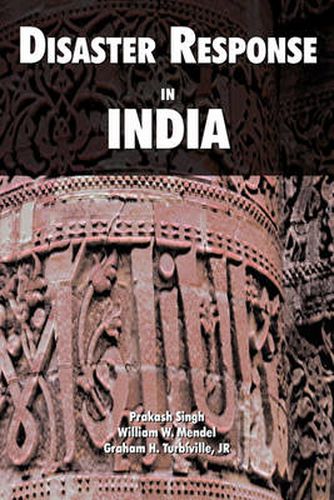Readings Newsletter
Become a Readings Member to make your shopping experience even easier.
Sign in or sign up for free!
You’re not far away from qualifying for FREE standard shipping within Australia
You’ve qualified for FREE standard shipping within Australia
The cart is loading…






This title is printed to order. This book may have been self-published. If so, we cannot guarantee the quality of the content. In the main most books will have gone through the editing process however some may not. We therefore suggest that you be aware of this before ordering this book. If in doubt check either the author or publisher’s details as we are unable to accept any returns unless they are faulty. Please contact us if you have any questions.
First published in 2000. Abstract: India is prone to natural and man-made disasters. The number has been increasing every year because of the mixture of various factors such as adverse weather, population growth, urbanization, and industrialization. How the Republic of India organizes for managing significant natural and man-made disasters, its capacity for effective response, and its ability to achieve unity of effort among governmental and non-governmental organizations are the elements of analysis here. This is of interest because India is an emerging world power; it is currently the second largest country in the world in population, and by 2050 it will have surpassed China as the largest. The number of Indians affected by disaster events shows a steady upward trend. Disasters have been taking a heavy toll of human and animal lives. Floods have proven to be the most devastating type of natural disaster in India, causing the maximum number of deaths and damage to property (cyclones have taken a heavy toll of lives and caused widespread devastation). At the same time, droughts affect a large segment of population, resulting in loss of employment and migration to other regions. Earthquakes have caused a comparatively lower amount of damage, but landslides are likely to increase in frequency in the coming years because of deforestation and over development on hillsides. Conurbation and industrialization have combined to create a dangerous synergy that now presents a significant hazard to India’s people. In responding to these kinds of hazards, India’s disaster management officials and professional humanitarians conduct disaster planning and response generally within a paradigm of three phases: Pre-disaster; Emergency (or Disaster Impact); Post Disaster (or Recovery). There is a strong emphasis in government policy and planning to encourage mitigation, i.e., actions taken prior to the occurrence of a disaster, including preparedness and long-term risk reduction measures.
$9.00 standard shipping within Australia
FREE standard shipping within Australia for orders over $100.00
Express & International shipping calculated at checkout
This title is printed to order. This book may have been self-published. If so, we cannot guarantee the quality of the content. In the main most books will have gone through the editing process however some may not. We therefore suggest that you be aware of this before ordering this book. If in doubt check either the author or publisher’s details as we are unable to accept any returns unless they are faulty. Please contact us if you have any questions.
First published in 2000. Abstract: India is prone to natural and man-made disasters. The number has been increasing every year because of the mixture of various factors such as adverse weather, population growth, urbanization, and industrialization. How the Republic of India organizes for managing significant natural and man-made disasters, its capacity for effective response, and its ability to achieve unity of effort among governmental and non-governmental organizations are the elements of analysis here. This is of interest because India is an emerging world power; it is currently the second largest country in the world in population, and by 2050 it will have surpassed China as the largest. The number of Indians affected by disaster events shows a steady upward trend. Disasters have been taking a heavy toll of human and animal lives. Floods have proven to be the most devastating type of natural disaster in India, causing the maximum number of deaths and damage to property (cyclones have taken a heavy toll of lives and caused widespread devastation). At the same time, droughts affect a large segment of population, resulting in loss of employment and migration to other regions. Earthquakes have caused a comparatively lower amount of damage, but landslides are likely to increase in frequency in the coming years because of deforestation and over development on hillsides. Conurbation and industrialization have combined to create a dangerous synergy that now presents a significant hazard to India’s people. In responding to these kinds of hazards, India’s disaster management officials and professional humanitarians conduct disaster planning and response generally within a paradigm of three phases: Pre-disaster; Emergency (or Disaster Impact); Post Disaster (or Recovery). There is a strong emphasis in government policy and planning to encourage mitigation, i.e., actions taken prior to the occurrence of a disaster, including preparedness and long-term risk reduction measures.